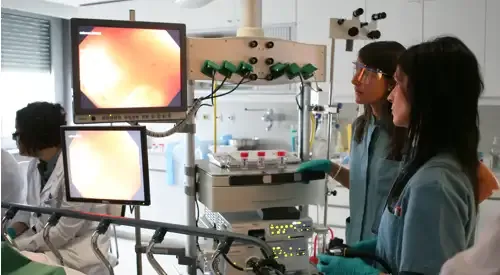Zenker Diverticulum
"Zenker's diverticulum is the most common variety of esophageal diverticulum. It is located at the pharyngoesophageal junction".
DR. Mª TERESA BETÉS
SPECIALIST. DIGESTIVE DEPARTMENT

Diverticula are disorders characterized by a protrusion of the mucosal and submucosal layers that cover the walls of the organ affecting it through the muscles that make it up.
Their maximum incidence is between 50 and 80 years old.
Most esophageal diverticula settle close to the sphincters as they are usually the result of esophageal motility disorders.
It is an infrequent, but not exceptional pathology, and can be very disabling if there is dysphagia and even potentially serious when accompanied by aspiration.

What are the symptoms of Zenker's diverticulum?
Although it may sometimes be asymptomatic, most patients with Zenker's diverticulum develop symptoms in the early stages, and these symptoms become more pronounced as the disease progresses as the diverticulum grows.
The most common symptoms are high dysphagia, sialorrhea, halitosis, noisy swallowing, regurgitation of the diverticulum contents into the mouth and sometimes symptoms related to micro aspirations such as irritative syncopal cough, wheezing, etc. Some patients perform maneuvers such as coughing or manual compression at the cervical level to facilitate swallowing.
In advanced stages we can find weight loss and symptoms derived from pneumopathy secondary to aspirations.
The most common symptoms are:
- High dysphagia.
- Sialorrhea.
- Halitosis.
- Noisy swallowing.
Do you have any of these symptoms?
You may have a Zenker diverticulum
How is Zenker's diverticulum diagnosed?

Once this pathology is suspected by the clinic, the next diagnostic step, and almost always definitive test, is the baryta transit that will clearly demonstrate the presence of the sac.
In patients with a long history of microaspirations, the study of lung function prior to surgery is essential to assess the state of the respiratory system.
¿Cómo se trata el divertículo de Zenker?
As an alternative to surgery, there is the endoscopic treatment, which is just as effective as the surgical treatment but with some added advantages.
The endoscopic section of the common esophagodiverticular septum (tissue bridge between the diverticulum pouch and the esophageal light) by means of electrocoagulation, CO2 laser or mechanical suture, manages to section the cricopharyngeal muscle and increase the diameter of the diverticulum mouth, thus facilitating its emptying into the esophagus.
The endoscopic treatment requires a shorter hospital stay than the surgical one (1-2 days), with a quick recovery afterwards, allowing an early oral intake.
Treatment of Zenker's diverticulum can be surgical, and all symptomatic patients should be considered candidates for surgery, regardless of the size of the diverticulum, even at advanced ages.
There are several surgical techniques, with diverticulectomy (removal of the diverticulum) plus myotomy (section of a muscle performed to access the underlying tissues or to relieve a sphincter constriction) of the cricopharyngeal muscle being the one of choice.
Where do we treat it?
IN NAVARRE AND MADRID
The Department of Digestive
of the Clínica Universidad de Navarra
The Digestive Department of the Clinica Universidad de Navarra is composed of a multidisciplinary team of specialists who are experts in the diagnosis and treatment of diseases of the digestive tract.
Our objective is that each diagnosis be carefully established and the treatment plan adjusted to each patient.

Why at the Clinica?
- Medical specialists who are national references.
- Specialized nursing team.
- Endoscopy Unit and High Risk Digestive Tumor Prevention and Consultation Unit to offer the best care to our patients.















